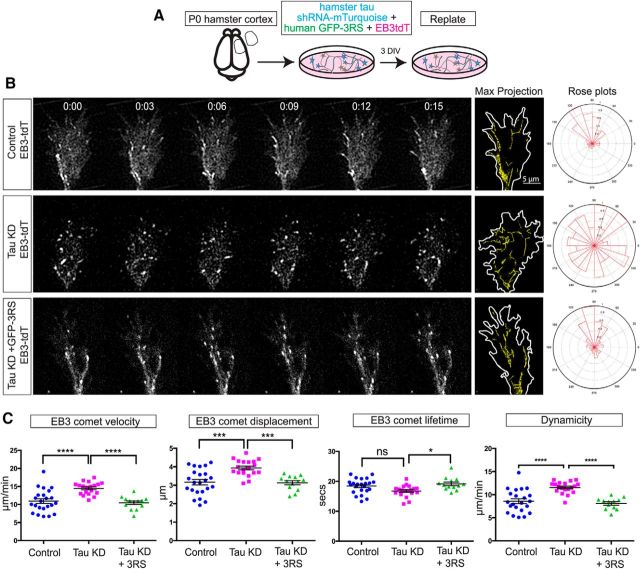Figure 5.
Tau knockdown misorients dynamic MT trajectories, which are rescued by human tau expression. Neurons nucleofected with control shRNA or tau shRNA and cotransfected with EB3td tomato to label the dynamic plus ends of MTs at P0 (A) were replated and imaged live with TIRF microscopy (B). Image sequences at 3 s intervals from a control growth cone (B, top row; Movie 3) show relatively straight EB3 comet tracks in parallel arrays. This was confirmed in the maximum projection image (right) where EB3 comets were pseudocolored yellow and in measurements of EB3 comet track angular displacements (rose plot, far right). Following tau knockdown (B, middle row) EB3 comets were disorganized (Movie 3) as shown in the maximum projection image (right) and in rose plots (far right). Image sequence of a growth cone (Movie 3) after tau knockdown and transfection with human tau (B, bottom row) shows that human tau rescues straight EB3 comet trajectories similar to those in control growth cones as shown in the maximum projection image (right) and rose plot (far right). Scatter plots (C) of EB3 comets obtained from movies (10 min duration with 3 s acquisition intervals) of control, tau knockdown and tau rescue growth cones (n = 20 for each condition) show that tau knockdown increases EB3 comet velocity, displacement, and dynamicity (see Materials and Methods) but not comet lifetime. All EB3 comet parameters were rescued with human tau. ns - not significant, *p < 0.05, ***p < 0.001, ****p < 0.0001. Scale bar, 5 μm. Comparisons of dynamic parameters of EB3 comets under different conditions shown in Figure 5-1.

